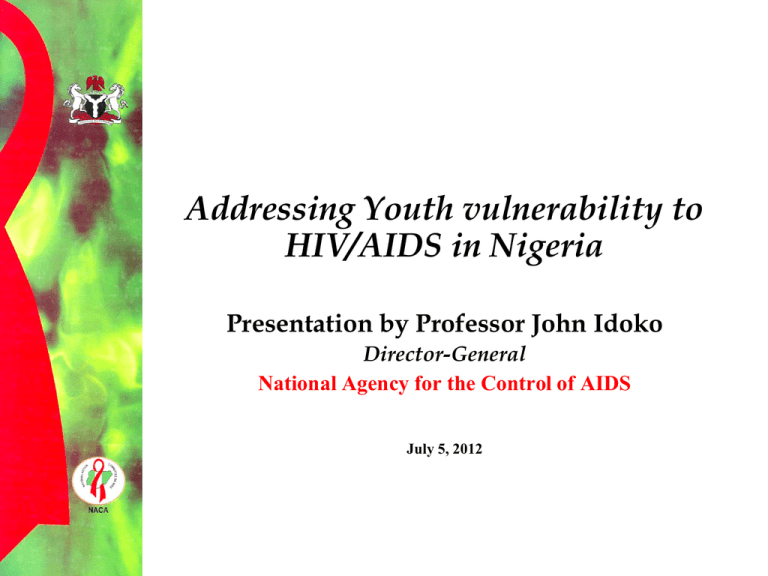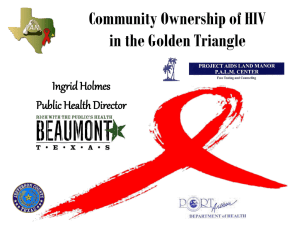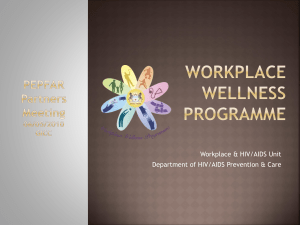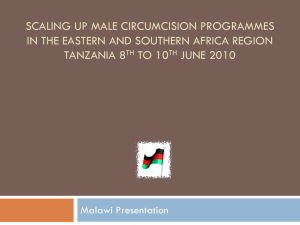
Addressing Youth vulnerability to
HIV/AIDS in Nigeria
Presentation by Professor John Idoko
Director-General
National Agency for the Control of AIDS
July 5, 2012
Introduction
•
•
•
•
Epidemiology of HIV in Nigeria
Young People – Why vulnerable?
Why focus on young people?
Taking the lead to protect young
people in Nigeria
• Are we keeping our promise?
Voice of young people in Policy
formulation/program coordination
• Conclusion
Why focus on young people?
• Of the 1.7 billion young people globally,
5.4 million living with HIV
• 40% new HIV infections among young
people
• Young people have the highest rates of
STIs
• Young people between 15 – 30 years
make up to 45 – 50% of Nigerian
population
• In Nigeria 60% of HIV prevalence
among young people
National HIV Prevalence Trend 1991 – 2010 (FMOH)
Where we are now with UA?....still
far away (2010)
•
•
•
•
•
•
•
•
No. of PLWIH
HCT coverage
PMTCT coverage
Annual HIV+ Birth
New infections
Number on ART
Number req ART
Total orphaned by AIDS
3.11 million
18%
32%
70,000
339,016
432,000 (30%)
1.5 million
2.23 million
6
HIV Prevalence by Age Groups
FMOH, 2011
Women and Girls
• HIV is a leading cause of death and disease
among women of reproductive age (15 –
49years) in sub-Saharan Africa.
• In sub- Saharan African, 60% of the People
Living with HIV is female (while women make
up 50% of the global epidemic).
• In Nigeria prevalence among young women
aged 15 – 24 years is estimated to be three
times higher than among men of the same
age.
• Females constitute 58% (about 1.72 million) of
persons living with HIV in Nigeria.
• Each year, 55% of AIDS deaths in Nigeria
occur among women and girls
HIV prevalence among women aged 15-24 years by location, North Central Zone
(HSS 2010)
Fig 3.0: HIV Prevalence among Women 15-24 years in
Benue State 2005-2008
12
Prevalence (%)
10
8
6
4
2
0
2005
Year
Urban
Rural
2008
National
What risk factors...?
• Early age at sexual initiation
• Heterosexual transmission
–
–
–
–
–
Biological vulnerability
Lack of recognition of partner’s risk
Inequality in relationship
Sex with older men (more likely with HIV)
Gender norms & Gender violence
• MSM
–
–
–
–
Less likely to disclose sexual orientation
Less likely to have HIV test
Likely to have 1 or > female sex partners
Infected MSM may transmit to men/women
AGE AT FIRST SEX
0.18
0.16
0.14
0.12
0.1
0.08
0.06
0.04
0.02
0
virgins
12
14
16
18
20
22
AGE
Halt AIDS, 2006
24
don't
know
AGE AT FIRST SEX BY SEX DISTRIBUTION
18
16
PERCENTAGE
14
12
10
8
6
4
2
0
<12
13
15
17
19
21
23
25
AGE
female
male
Halt AIDS, 2006
don't
know
Age distribution of MSM in Abuja, Nigeria
S/N
Age group
Frequency
1
15 - 19
15
5.1
2
20 - 24
108
36.6
3
25 - 30
116
39.4
4
30 - 34
45
15.2
5
35 - 39
10
3.4
6
40 - 44
0
0
7
45 - 49
1
0.3
Total
295
100
CRH, 2009
%
Risk Factors
• STIs
– Young people have higher prevalence of STIs
- increased likelihood of HIV
• Alcohol, tobacco and drugs
– Both casual and chronic users more likely to
engage in high risk behaviour such as
unprotected sex
• Lack of awareness of risk/vulnerability
– Low perception of risk among young people
• Population Effect/Family level
vulnerability
– Generating ever increasing cohort of sexually
active susceptible to HIV
Risk Factors
• Poverty and out of school youths
– Socio – economic problems associated with
poverty can increase risk of HIV:
– Poor education
– Poor information on HIV, RH & condoms
– Lack of high quality health care
– Poor condom use
• Coming of age of HIV +ve children
– Young people who acquired HIV perinatally
facing decisions about becoming sexually
active
– Will require counselling
Comprehensive Knowledge about HIV
Characteristic
Female (%)
Male (%)
Age: 15 - 19
19.7
28.2
Age: 20 - 24
24.8
37.2
Urban Residence
29.8
39.7
Rural Residence
17.9
28.2
Comprehensive Knowledge
Consistent use of condoms
Having one faithful –ve partner
Know that healthy person can have HIV
Rejecting 2 common local myths about HIV transmission
NDHS, 2008
ZERO NEW HIV INFECTIONS.
ZERO DISCRIMINATION.
ZERO AIDS-RELATED DEATHS.
3 Strategic Directions
Revolutionising HIV
prevention
Political commitment to why
people are getting infected
and reduce new infections
Mobilize communities to
demand transformative
change
Resources directed to
hotspots and what works
Catalysing the next phase
of treatment, care & support
Access to effective treatment
when people need it
Strong national & community
systems to deliver services
Access to care, support &
nutrition and social protection
Linkages with maternal and
child health, SRH, TB…
Advancing human rights &
gender equality
Protective social & legal
environments enable access
Equitable service provision
reaches people most in need
HIV-related needs and rights
women and girls addressed
Reducing Youth Vulnerability
• Education on sexuality and RH
• School Attendance esp Girl child
• Cultural norms/values
– Virginity and Abstinence before marriage –
values for girls & boys
– Sexual behaviour tolerating multiple sex
partners
• Access to condoms
• Migrants are vulnerable
• Alcohol & Drugs
Prevention Strategies
Making HIV testing a mature part of medical
care (PIT) & Implementing new models of
diagnosing HIV infection outside medical
settings
– Prevention of new infections by working
with HIV infected persons and their
partners
– Decreasing Perinatal infections (eMTCT)
– COMBINATION PREVENTION + NPT
• PrEP and Treatment as Prevention
• Role of Parents, Schools, Churches &
communities
– Prevention programs
– Awareness for responsible sex behaviour
Contribution of the 20 countries with the largest numbers of women
needing antiretrovirals for preventing the mother-to-child transmission of
HIV to the global gap to reach 80% of those in need, 2008
Role of Government
• Role of Federal Ministry of Education &
Youths line Ministries supporting multisectoral response
• Role of State Ministries of Education
• Role of NACA, SACAs & LACAs
–
–
–
–
FL& HIV education (curriculum)
NYSC HIV project
AIDS & RH clubs in secondary schools
GS curriculum in Universities & expanded
curriculum in medical & nursing schools
– Youth Friendly Centres in Universities
Commissioning of Youth Friendly Centre, OOU, Ago- Iwoye
National Call Centre Update
The centre is set to harness the vast potential of
telephone through public-private partnerships
Airtel has provided an E1 line with capacity for 30
toll free voice calls + 2 data lines
ETISALAT already key in to provide free services
NACA procured office space in Central Area close to
NACA office in Abuja
Skye and Access Banks have supported furniture
and hardware respectively
NACA sourced robust user friendly software from
India and installation of E1 hardware completed
Access Code – 6322 ONLY ON AIRTEL FOR NOW
National Reproductive Health,
HIV & AIDS Prevention and Care
Project through the NYSC
Project Goal
Increase RH/HIV knowledge among
corpers
Provide life skills & promote peer
education
Support protective behaviour in
communities of primary
assignment
Sensitization of Students in
Schools
Project Achievement
Activity
Beneficiaries
Orientation Seminar
Corps members/
NYSC staff
Training Peer Educator Corps members
Trainers (PETs)
No. reached
Duration
1,157,571
2002 to 2011
77,325
2002 to 2010
Training Peer
Educators (PEs)
Secondary
School Students
29.8 million
2002 to 2011
HCR
Corps Members
2003 to 2008
HCT
Corps Members
Training of Peer
Influencers (PIs)
Staff
<1,800
185
222
Project Management
and Supervision
Sch. Officers/
Zonal Inspectors
<1,000
2003 to 2005
2010 to 2011
2007
Are we keeping our promise?
• Importance of preventing HIV in young
people has been a consistent message:
– ICPD +5, MDG, UNGASS, Political
commitment of UN General Assembly in
2006
• Calls on Governments to ensure HIV rates in
persons 15-24 should be reduced by 25% in the
most affected countries by 2005 and by 25%
globally by 2010.
• Young people’s voices in policy and
programs in Nigeria
– Youth HIV network – NYNETHA, APYN
– Role in NACA, CCM, CCEs
– Regional networks & UN meetings
Conclusion
• Various prevention strategies have
proven effective to address youth
vulnerability; they include
• HIV counseling and testing
• Condom us
• Reduction in sexual partners
• Raising the age of first sexual activity
• Education – attending school especially
for GIRL CHILD education
• RH education including FLE & HIV
education
Success is determined by..........
• Political support for HIV prevention
• Active role of communities and grass roots
initiatives
• Involvement of PLWHV
• Communication & information including on SRH
• Creating enabling environment for youths to
protect themselves and others
• Combating and reducing stigma, discrimination,
denials and taboos
• Protecting and promoting HR including the rights
of women & children
• Increased access to ART
• Integrating comprehensive HIV services with
SRH
THANK YOU








